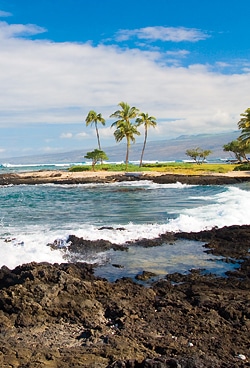The Aloha Code
Hawaii lives in contradiction — American but separate, touristy but layered, welcoming but sometimes wary. The Big Island's traditions and natural beauty transform the quest for acceptance into a journey worth every step.
Maybe we've made a mistake. We're on a remote corner of Hawaii's Big Island, at a surf beach we were categorically warned was for "local bruddas only." I think my husband is about to get killed. He's tall, and I've always considered him well built, but compared to the group of surfers on the beach, he suddenly looks puny, white and vulnerable. Yet Greg plans to surf.
I scurry off to a small patch of sand and pretend I'm not with the little guy. Greg takes his board and walks down to the shore. Four muscular, tattooed guys, surfboards under their arms, swing around and glare at him. I picture their boards morphing into Uzis — rat-tat-tat-tat and Greg's a goner, one less haole to hog the waves.
But instead of plunging in immediately, Greg sets his board aside, sits and watches. The sun, near the horizon, lays a metallic path on the ocean. It's late in the day, and there are 25 surfers in the water. Harsh black lava rock surrounds the small dark-sand beach. The waves are smashing the shore. What must the first Hawaiians have thought, having sailed some 2,000 miles from their idyllic homeland in central Polynesia to land near this stark strip of earth more than 1,500 years ago? Surely they felt some disappointment — until they saw the rest of the island.
Most of the surfers on the beach now are Hawaiians or mixed Hawaiian-Chinese, and they're mainly impressive wave riders. Greg studies the lineup. It's crowded, and even from where I sit I can hear angry voices when one surfer drops in on another. Greg waits a good 30 minutes, during which time many of the locals leave the water. Only then does he head in. I see him bobbing out there, waiting for the swell. He has a few good, clean rides and keeps heading farther out. Then I see him paddle over to the guy next to him. "Oh, God, no," I think, "don't let him try to make friends."
Surfing is competitive everywhere these days, and since the sport was invented long ago by the Polynesians, it can be particularly territorial here. There is a strict behavioral code, and I fi gure it doesn't include outsiders making small talk with the bruddas.
Turns out I'm dead wrong. An hour later, after a great session, Greg swaggers up the beach with one of his new buddies. "See ya, dude," the guy says, giving the thumb-and-pinkie surfer salute. I look at my husband with new respect. He made it out alive.
"It's all about the aloha spirit," Ed Divita, a friend who spent 10 years living on the Big Island, told me. "And respect. When haoles on vacation come here and pretend to know the culture, they're seen as idiots. Or worse, if they just ignore the culture and impose their own, then there's trouble. But if you show respect, and you don't try to act Hawaiian when you're not, then you get to experience true aloha spirit."
The best definition I could find for aloha spirit was the practice of peace, kindness and fellowship for all. Why then did I sometimes feel like an outsider in Hawaii? Granted, I'm the most haole of haoles — so pale an Angolan elder once compared me to a boiled chicken. So I can hardly blame them if Hawaiians lump me together with the white colonials, the same people many believe disenfranchised them nearly 200 years ago.
There is a movement all over the South Pacific — from New Zealand to Hawaii — to reclaim culture and reinstitute the old Polynesian ways. The schools teach native languages again; the swanky restaurants put indigenous foods on menus; and traditional healing and spirituality are practiced alongside Western medicine and Christianity. But this revival process also eschews all things colonial, and some of that suspicion may extend to white tourists, a.k.a. haoles.
Negative etymologies for the term haole suggest "thief" and "one who does not share breath," but pre-European Hawaiians probably used the word simply to mean "foreigner," referring to new arrivals from other parts of Polynesia. Today the word denotes "white person." It's not usually meant as an insult, but it certainly figures whites outside the culture.
Greg's surfing experience gave me hope that if not cultural oneness, then at least acceptance might be possible. But I wanted to know how the Hawaiians felt. Is the distance I sometimes feel real? And if so, what can I do to bridge it?
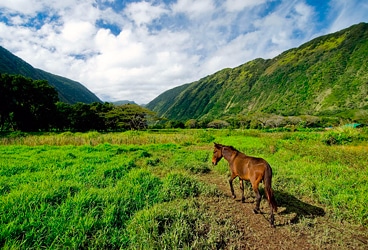
We eased into our trip, staying first at Mauna Lani, a 3,200-acre development on the sunny Kohala Coast, north of Kona. A marvel of engineering, with green grass floating in a sea of black lava, this was the kind of tropical resort most travelers come to Hawaii for. You may not find true, out-ofthe-way Hawaiian life here, but our two kids loved it, and we got our fix of white-sand beach.
Mauna Lani sits on the site of some of the Big Island's oldest ruins, and the resort has preserved them well. Wandering past the royal fi sh ponds, I met Danny Akaka, son of U.S. senator Daniel Akaka and director of cultural affairs at Mauna Lani.
"Oh," he responded to me when I asked about the cultural revival, "I consider myself one of the early members of the Hawaiian revivalist movement. We were students in the 1970s, some of the first Hawaiians to take Hawaiian studies courses. No one had thought to dedicate a whole department to Hawaiian studies before 1971."
Today Akaka's job is to ensure that in spite of tourist development, visitors know they're in Hawaii, that they come to respect the aloha spirit and that they leave having learned something about the culture. Although a world authority on Hawaiian history and tradition , he makes his living out of tourism. This is a pervasive dilemma for Hawaiians. The economy now depends on tourism, yet some argue that the flood of tourists in the last few decades has eroded both land and culture.
As part of my informal investigation here, and in honor of my birthday, I arranged for a famous local chef to come to our Mauna Lani condominium and prepare a Hawaiian feast. Chef Olelo pa'a (Hawaiian for "spark of existence") practices Hawaiian healing and spirituality. Her website calls her method "conscious Hawaiian cuisine." "This kind of cuisine," she writes, "allows the mana (life force) that I put into the food to become more nourishing for the mind, body and spirit. By cooking this way, not only do I satisfy my guests opus (stomachs), but I fill their souls with aloha (love)."
At the appointed time, Olelo pa'a breezed in, bringing two helpers, food to feed a village and an aura of enlightened happiness. There was just one surprising detail: Olelo pa'a looked 100 percent Japanese. As she serenely whipped together five fantastic, locally sourced courses like ahi tartare and hoi'o fern shoots, the cheerfully pretty, five-foot-nothing Olelo pa'a, whose birth name was Faith Ogawa, told us about herself. "I am Japanese by descent," she said, decorating kampachi carpaccio with an orchid. "My grandparents were brought to Oahu to work the sugar-cane fields. But I'm Hawaiian. My Hawaiian name was given to me by a kahuna (wise man). I've studied Hawaiian cooking and Hawaiian healing practices."
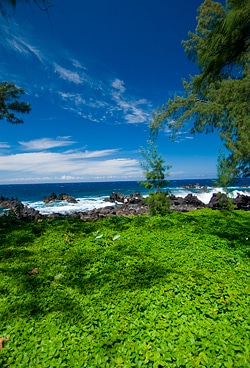
This got me wondering what it means to be Hawaiian today. Who is Hawaiian? Who is not? How has history merged a myriad of ethnicities into one South Pacific culture, and does that culture leave whites on the outside? After American mainlanders settled in Hawaii, they imported Chinese, Japanese, Filipino and Portuguese laborers to work their sugar fields, pineapple plantations and cattle ranches. Those workers stayed, many marrying Hawaiians, creating the ethnic melting pot Hawaii is today. Olelo pa'a Faith Ogawa is a living example of Hawaii's acceptance of other ethnicities. Although she looked like she could have been from Tokyo, she talked about Hawaiian history in the "we," embellished her English with Hawaiian idioms and seemed to have an abundance of aloha spirit. I envied Olelo pa'a her entree into the inner Hawaiian cultural circle. I would hazard a guess that even if I took up residence in Hawaii, a boiled chicken such as myself would never have the same access.
When I asked her if she'd ever been to the Waipi'o Valley on the north coast, a place I'd heard was gorgeous and sacred to Hawaiians, she immediately offered to take me there herself. "We must go tomorrow!" she announced. "I have a friend who grows taro in the valley. His family has lived there for centuries." Apparently Kamehameha, the aggressive but heroic warrior king who eventually fought and united the Hawaiian Islands, was raised and received his training in this remote place. "It is a place where many kings are buried," Olelo pa'a informed me. "Their mana protects the valley."
A warm, languid rain fell on the precipitous dirt road as we drove into the vast valley. About the size of Manhattan with only 50 full-time residents, Waipi'o is still virginal, with waterfalls gushing from its flanks and a lonely arc of black-sand beach at its head. "Did you let your friend know we were coming?" I asked Olelo pa'a, worried we were making a terrible haole gaffe by rocking up uninvited. "Never worry about Jason; he's filled with aloha," Olelo pa'a replied, doing nothing to assuage my doubts. Aloha spirit or not, I don't think I would take too kindly to a bunch of tourists showing up on my doorstep, especially in the middle of a workday.
We parked and forded a river on foot, then walked through dense, emerald bush to a rambling shack set beside stacked-rock taro pools. Knee-deep in the muddy water was Jason Mock-Chew. He smiled ever so slightly, taking my hand in a vise grip. "Aloha," he said in a soft voice, "you are welcome in Waipi'o." The man obviously had major mana. It buzzed around him.
Taro, Jason told us, was the staple diet of early Hawaiians, brought on the first canoe from Polynesia. Served traditionally, it's mealy and bland (at least to me), but it's rich in vitamins, minerals, fiber and correct carbs — a wonder food. Hawaiians love it. "I have to ration what I sell," Jason said. "I can't grow enough to keep up with demand."
I could not detect an iota of hostility in Jason. He talked and moved deliberately, and spoke warmly of the groups of backpackers he allows to camp on his land. His taro farm seemed about as close as we could hope to get to "Hawaii for Hawaiians."
After Waipi'o, we headed east through the ranchland town of Wailea and south to Hilo on the east coast. The farther we got from Kona, the more traditional life seemed. Cowboys in spurs rode horses down dirt tracks, children walked barefoot, women sat under trees gossiping while old men leaned on canes watching the cars go by. Located on the rainy side of the island, Hilo doesn't get as many tourists as the Kona side.
Above the town stood the lovely Shipman House Bed and Breakfast Inn, a restored mansion built in 1899. Once the town home of W.H. "Willie" Shipman, a wealthy cattle rancher and the son of missionaries, it's now owned by his great- granddaughter. The establishment suggests a Hawaii where settlers upheld proper Bostonian manners despite the crushing humidity and discomfort of life in the tropics. It was easy to picture wilting, corseted women sipping tea on the screened porch while workers sloshed through the rain, raising cattle to provide mainlanders with prime rib.
I noticed how the white Hawaiians who have been here for generations uphold their own brand of aloha spirit — keeping alive the memories and reputations of relatives who built Hawaii's industries. Family histories are published, sepia photos hang on walls and antiques are reverently guarded. The Hawaii these people know is the white man's Hawaii, but it is as beloved as anyone's homeland.
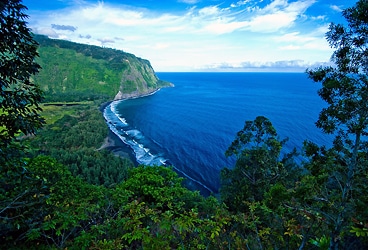
These "white" Hawaiian families almost always have some Hawaiian blood somewhere, but usually it does not reach the 50 percent minimum the federal government requires for someone to be considered native Hawaiian . That can make things tough. These families grew up here. Their whole context is in the islands. But are they considered truly Hawaiian? When I asked white Hawaiians, they unhesitatingly called themselves locals, islanders, Hawaiian before American. But ethnic Hawaiians — the ones with at least 50 percent native blood — generally shrugged. A few said no, considering these families colonial vestiges.
Later I spoke with Tom Pohaku Stone, a native-born professor of Hawaiian studies at the University of Hawaii and a man determined to take back Hawaii and reinstate traditions. Stone was forthright about the issues he has with foreigners who have driven up realestate prices and laid claim to Hawaii's history and natural resources. He cannot abide the fantasy culture created just for tourism.
"After people like Jack London came to Hawaii and romanticized our culture, the wealthy mainlanders rushed here. The Hawaiian culture that emerged was one created by Americans for tourists." Having endured tacky hotel hula dances performed by girls in lacquered coconut bras, I sympathize with him on that point.
"In the late 1970s," Stone told me, "the movement to be recognized not as a commodity but as a people emerged. We wanted our identity and our country back. For 150 years we had lost our land, spoken another language — our native language was outlawed — worshiped foreign gods, used foreign medicines, adopted foreign manners. We realized our culture was dying out, and we had to take a stand to stop that from happening." I asked Stone what, if anything, he thought outsiders could do to avoid being resented. "Stop romanticizing Hawaii," he said. "Hear our voices. Respect our culture as a part of the nice beaches and the surfing and the warm climate. And support us in protecting what is left to us."
Amid these intense discussions, my family and I kept pushing farther off the Big Island's beaten path. We had rented a vacation house in lush Kapoho, about 40 minutes south of Hilo on the east coast, in the shadow of the very active Kilauea volcano. This area gets considerably less rainfall than Hilo, a big plus for me. Kapoho also has a string of warm lava-heated pools, good for swimming and snorkeling with turtles.
Native Hawaiians have owned vacation houses in Kapoho for centuries, many of them thrown-together huts that sleep the extended family on weekends. In the past few decades, however, mainland Americans have bought land and built large houses side by side with the humble Hawaiian structures. Our own rental house, the Shangri-La, was beautiful, offering tropical serenity and a private hot pool.
Across the road, a large Hawaiian family occupied a small house. It took several days for us to meet, but chummy Greg finally took over some beer and joined the family on their front lawn as their kids dive-bombed their hot pool. A couple of bottles later, I joined them. The family's grandfather, a distinguished-looking man, chuckled when I asked about the new haole houses.
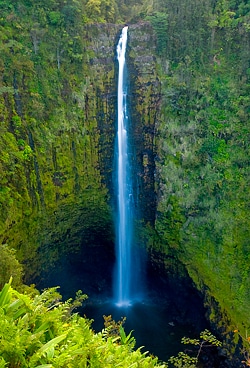
"Oh," he said, shaking his enormous head, "Kapoho is in Zone One for the volcano. You know what that means? It means when Kilauea blows we all get covered in lava. And these big houses, they go too." He gestured to his patched-up box and said, "Mine I just rebuild in a week."
His words conjured disturbing images — haoles frozen in poses of terror, Pompeii-style, caught in a sea of lava while rescuing their microwaves. "No, no," the neighbor assured me, "Kilauea has slow-flow lava. Plenty of time to get out." Sharing a beer with him and his family was a most pleasant experience. He clearly wasn't thrilled by the building frenzy, but he did not appear bitter.
Near the end of our trip, I thought back to the locals-only surf beach with its lovely golden light and seemingly hostile local surfers. Greg, a haole tourist with a surfboard, hadn't adopted my anxiety or resigned himself to his own exclusion. Instead he took time to observe the scene, then entered it without any air of entitlement. "It's easier to resent an entire people than an individual who treats you well," Greg said. And he was right. Every Hawaiian I'd spent time with, spoken to, asked questions of — they had all been warm, gracious and welcoming.
And that was the way from haole to aloha, I decided. Admit you're on Hawaiian turf and let Hawaiians go first for a change. Acknowledge that Hawaii is more than a decompression chamber for stressed-out mainlanders and that Hawaiian culture is sophisticated and insightful, worth discovering and worth preserving. Then be open and friendly, even if faced with hostility. In a word — that two-way word that kept coming up — aloha spirit means respect.
